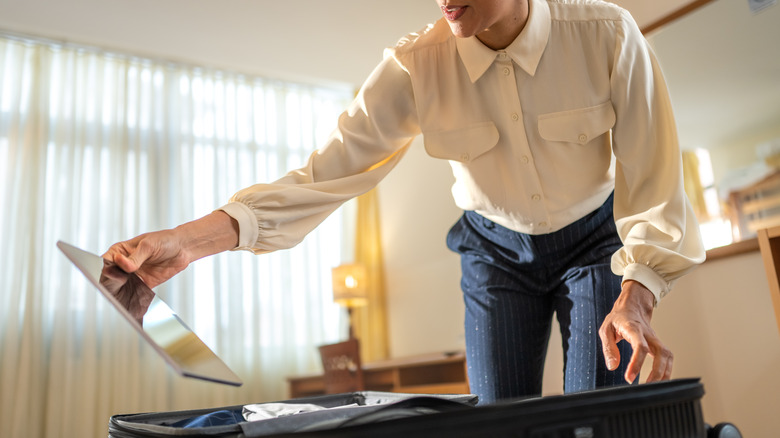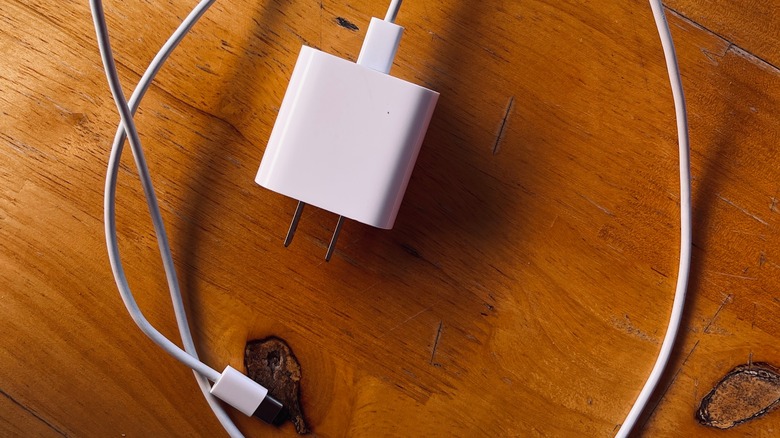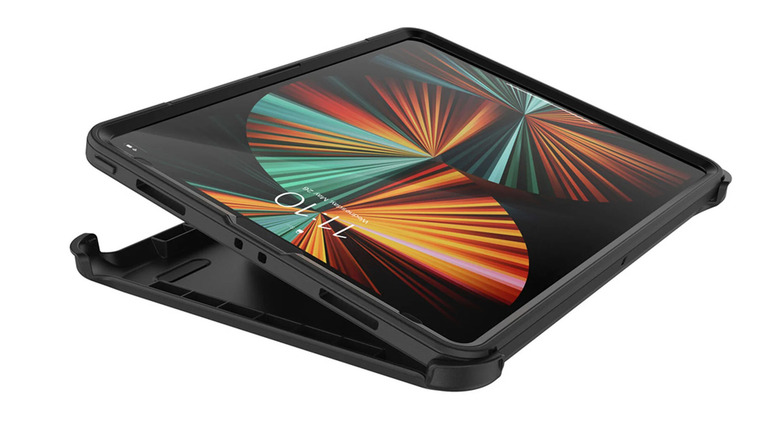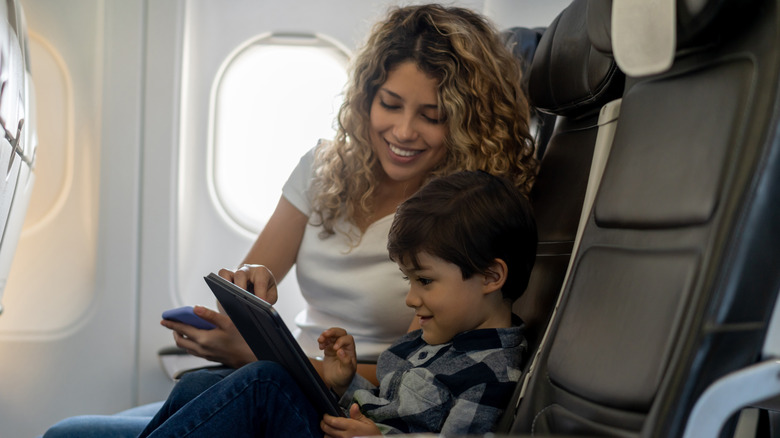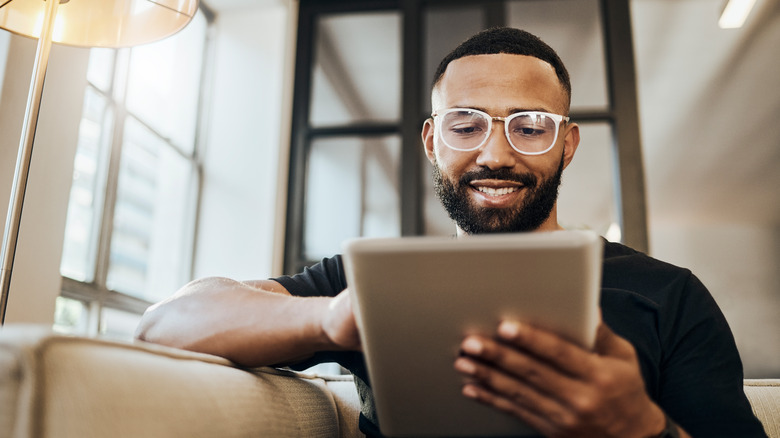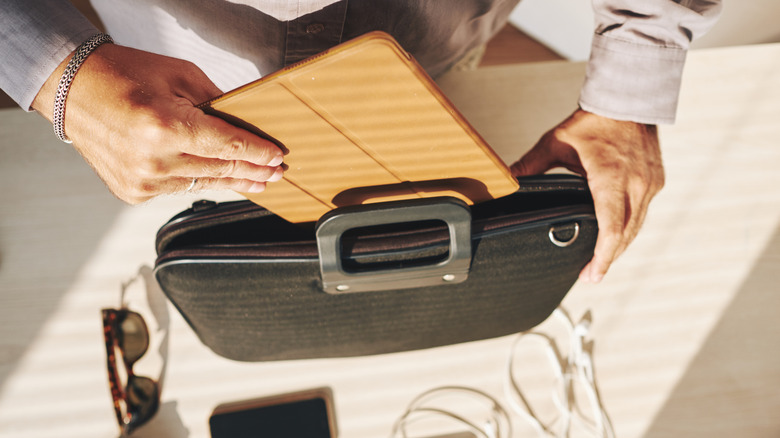5 Essential Tips To Know If You Travel With Your iPad
We may receive a commission on purchases made from links.
If you have one, an iPad is one of the best things you can bring with you on a trip. It's less bulky and more portable than a laptop but armed with the right apps and accessories, you may be able to accomplish the same tasks you would on a computer. It also has a bigger display than a smartphone, making it the perfect device to stream videos and play games on.
Before you go, though, it's important to go through all the motions and make sure that your iPad is travel-worthy. For starters, ensure that its version of iOS is up-to-date so that you're less prone to running into technical hiccups when using the device. If you're traveling overseas, consider purchasing a travel SIM for your smartphone or reaching out to your mobile service provider to find out if your plan includes international coverage. You can gain internet access on your iPad by tethering it to your phone's personal hotspot.
If you need a checklist, though, below are some important iPad-related tasks you need to accomplish before you hit the road. These tips are applicable for both domestic and international travel and can also be applied to mobile phone use.
Do not forget your iPad charger
Device chargers are highly essential and are often left behind. While packing for your trip, make sure you put your iPad charger in your bag. If you're going abroad, include a travel adapter so you can charge your device no matter what country you are in. If you anticipate being out and about for long periods and intend to bring your iPad with you, consider packing a portable power bank to charge the battery while you're on the go. If possible, purchase a spare iPad charger and assign that for travel use because you will likely need your main one to charge at home prior to leaving.
Having said that, make sure your iPad is fully charged before heading out the door. In addition, if you're traveling by plane, pack an extra standard USB (non-type C) charger cable so you have the option to plug it into an airplane seat port, if available.
Get you iPad a good quality case
In general, using an iPad without a protective case is incredibly risky, especially if you're planning to use it in public, where anything or anyone can cause you to accidentally drop, scratch, or damage your device. Find one that's made of sturdy, lightweight materials that won't make your iPad too bulky and potentially harder to handle.
The Apple Store should have several case and cover options for a variety of iPad versions. If you don't mind venturing into brands not necessarily affiliated with Apple, Amazon has several iPad protective cases that are more affordable. Make sure you go for a highly rated and thoroughly reviewed product.
While you're at it, buy an iPad screen protector as well. Pick one made of tempered glass so it's scratch-resistant and easy to install. If you're worried about privacy, you can go for an iPad anti-spy or privacy screen protector, which will look black at first glance but should be visible to anyone directly in front of the screen. Do note that if you opt for the privacy-type screen protector, it will essentially darken your screen a bit to prevent snooping, so you'll need to bump up your iPad's display brightness a bit.
Prep your iPad for use in unfamiliar surroundings
While it's highly possible that where you're going, there will be WiFi connectivity — or cellular connectivity for your mobile phone, which you can tether your iPad to — expect to have periods where you won't be able to access anything online. Before you go, download all the apps you'll need while traveling. This includes a navigation app — Google Maps allows you to save areas for offline use — and language translation apps if you're going international. Download any shows or movies you want to view offline while you still have a stable internet connection at home, so you don't have to use mobile data.
One of the most crucial iPad tricks you absolutely must do is enable your iPad's Find My function. This will give you the ability to track your iPad's location in case you misplace it, or it gets stolen. The Find My feature also lets you remotely lock or erase your iPad if you prefer.
Finally, suppose you intend to connect to public WiFi networks. In that case, you may want to consider using a VPN on your Apple device for added privacy and security before you do so. A VPN app can encrypt your data, making it harder for hackers to steal your personal information.
Back up your iPad regularly
With any form of travel comes the risk of potentially losing your devices or, worse, getting them stolen. While the idea of misplacing an expensive piece of equipment is already tough to begin with, losing access to data saved on it is an even bigger hassle. To prevent this type of mishap from happening to you and your precious iPad files, make sure you back up your iPad before you even leave for your trip. The best way to back up your iPad is by using iCloud so the device is automatically backed up whenever it's plugged into power, locked, and connected to WiFi. Here's how:
- Launch the Settings app.
- Tap your name.
- Choose iCloud.
- Go to iCloud Backup.
- Enable your preferred backup option.
- To back up manually, hit Back Up Now.
For safety's sake, it's a good habit to perform a backup whenever possible. Note that if you have a lot of stuff saved on your iPad, you might need to have a bigger storage option. Consider upgrading to iCloud+ if you need more than 5 GB of space. If you don't want to use iCloud, you can backup using your Mac or your Windows PC via the iTunes app.
Keep your iPad (and its contents) safe
Finally, ensure you have a top-tier quality travel backpack to put your iPad, other electronic gadgets, and travel essentials in. Keep it in a slot or sleeve dedicated to tablets — which most backpacks should have these days — when you're not using it. Never leave your iPad unattended in a public environment. When you do need to use it, make sure you employ active situational awareness: watch your surroundings, keep an eye on your iPad, and make sure you have a firm grip on it. Looking alert may discourage people who are planning to snatch your gadget away from you when you aren't expecting it. Adding a TSA backpack lock for extra safety measures also doesn't hurt.
It's also a good idea to enable a passcode or FaceID on your iPad. This ensures that strangers or pickpockets who try to use your device will be unable to easily do so. Launch the Settings app, go to Face ID & Passcode, and enable all the essential settings, particularly the one that requires Face ID to unlock your iPad and the one that erases all data on the iPad after 10 failed passcode attempts. Remember that if you enable the latter, you will need to take extra precautions to ensure your iPad screen doesn't accidentally come alive in your bag (while in your possession) with the passcode screen active.
